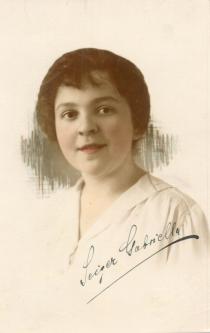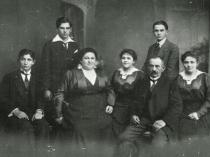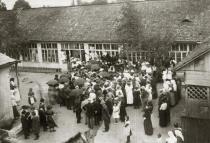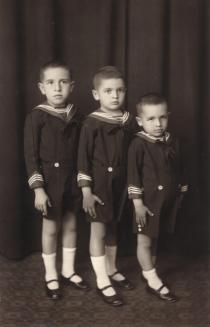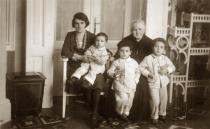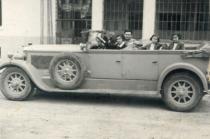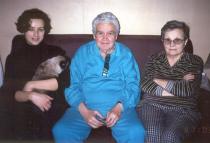
Deva
Romania
Interviewer: Oana Aioanei
Date of interview: October 2003
Mr. Lorincz is a rather short man who looks remarkably like his maternal great-grandmother, as his old photographs obviously show. He spends his mornings at the headquarters of the Jewish community in Deva, whose secretary he is. On Saturday mornings, he never misses attending the synagogue - even on good days, there aren’t more than eight men who gather for prayer. I first met him at the community’s office, located right next to the synagogue. When I visited him at home, I admired his neatly arranged library: he has about 2,500 books, including, for instance, an eleven-volume world history in Hungarian. The walls are decorated with paintings. He lives with his wife, his daughter, who has undertaken the process of restitution of the family property, and a cat, which they all consider the fourth member of the family. [Andrei Lorincz died in March 2005.]
My family background
My maternal great-grandparents, the Seigers, came from Peremishl [Przemysl], Poland. My maternal grandfather, Gottlieb Seiger, was born in 1864, in Hunedoara County, and lived in Deva. He was a butcher by trade. He had a brother, Lazar Seiger, who married Ida Czitrom from Blaj. They didn’t have children and Lazar died of tuberculosis, long before 1930; he’s buried at the Jewish cemetery in Deva. My maternal grandmother, Hermina, nee Roth, was born in 1878, in a village near Deva, I don’t know its name, and lived in Deva. She was a housewife. Both my grandparents were extremely religious, very Orthodox 1. But, despite that, they didn’t go to the synagogue every week, only during the holidays. My grandfather didn’t go during the week and not even on Saturdays.
My maternal grandparents’ house is still there today, but it no longer looks like it used to. It’s a 180-year-old house built at the time of my great-grandmother and great-grandfather. It fell into ruins in the 50 years of Communism and there’s not much of it left now. However, in my childhood, it looked all right, relatively well. It had three rooms and a kitchen; there was no bathroom. My grandparents had electricity, but no gas. The kitchen was plumbed. They didn’t have a garden, only a courtyard, and they had cows, horses, and a dog.
My grandmother was a nice person; she kept the accounts for my grandfather’s butcher’s shop. We didn’t use to eat at her place, but we visited her at least three or four times a week, especially because she lived very close to us: ten or twenty meters away. My most beautiful memory about my grandmother is that, every Sunday, before noon, my brothers and I would pay her a visit and she would give us money to go see a movie. Back then, a theater ticket cost about 1 leu and 50 bani. When the war started, in 1940, she didn’t live on her own, but with her granddaughter, Irina Lorincz. My maternal grandparents both died in Deva. My grandfather died in November 1924, and my grandmother on 17th January 1941.
My mother had two younger brothers: Bernat and Ernest. Bernat was born in 1900 and graduated from the School of Electrical Engineers in Bratislava. He lived in Deva and worked as a butcher and stock exporter. He was a very hard-working man and made a fortune after my grandfather’s death. He delivered cattle and swine – live or slaughtered. Uncle Bernat owned refrigerating cars. In winter, he stored ice in cellars; ice was collected from the Mures River. He went to many places, from Israel to England: he delivered cattle in Hungary, Czechoslovakia, Austria, Germany, England; he went to Constantinople [today Istanbul] or to Rome countless times, for instance. He traveled across the entire Europe from 1930 until 1940, that’s for ten years. Bernat never got married; he didn’t have a family. He died in 1980, in Deva.
Ernest was born in 1901. He worked as a butcher in Deva too. He sold both kosher and non-kosher meat. He and his wife, Gabriela Herschkowitz, had two daughters: Sonia, born in 1929 and Nadia, born in 1932. The family also raised a third child, Vera Breier, who was Gabriela’s daughter from her first marriage to a man named Eugen Breier. Ernest lived in two other places: he stayed in Cluj Napoca until he was arrested by the communist regime, but he never worked there, and in Ineu, where he died, in 1976. However, he was buried back home, in Deva. At that time, I was living in Ineu too; Uncle Ernest died at my place. His wife left for Israel before he died. Sonia and Nadia lived in Cluj until his death, and then they left for Israel too. Sonia married Doctor Mihai Marina and bore him a daughter, Marina Monica. Marina is a doctor in Fula, Israel, and is married to engineer Blanaru. Nadia married Victor Klein; the two of them had a boy, and then got divorced. Their son, Norbert Klein, became an engineer in Israel, but I don’t know where exactly he lives.
My mother, Gabriella Seiger, was born on 10th January 1899, in Deva. Between 1916 and 1918, she went to the Medical School in Budapest for two years. In 1918, when Bela Kun 2 brought Communism to Budapest, she came back home. [Editor’s note: Mr. Lorincz is talking about the 1919 events, when the Hungarian Soviet Republic 3 was proclaimed in Hungary.] Afterwards, she never went to college again and she married my father. He had been courting her ever since the age of four. He had met her while in kindergarten and he had waited until she grew up.
My paternal great-grandparents, the Lorincz family, came from amidst the Szeklers [specific Hungarian region called Szekler land situated south-east of Transylvania]. They were born in the commune of Corund, in the Harghita County. Francisc Rakoczi 4, the governor of Transylvania 5, required all of them to declare themselves either Szekler or Jews. Thus, a part of the community joined the Jews, and the other part stayed with the Szeklers. I believe my great-grandparents were pretty religious people, since they chose to declare themselves Jews. I don’t know how they ended up in Deva. [Editor’s note: In 1868 in Bozodujfalu most of the Sabbatarians 6 converted to Judaism and it’s very likely that Mr. Lorincz refers to this event. Ferenc Rakoczi II was the Prince of Transylvania and Hungary between 1704-1711, thus mentioning his name isn’t appropriate in this context. Moreover during his reigning, he didn’t force people to make such choices.]
My paternal grandfather, Daniel Lorincz, was born in 1870. He lived in Ilia, where he was in the shoemaking business; he was a shoemaker by trade. In 1921 or 1922, he moved to Deva, where he worked as a clerk in a lawyer’s office for the rest of his life. My paternal grandmother, Helen, nee Grun, was born in 1876 and lived in Deva too. She came from the commune of Barastii Iliei, near Hateg, in Hunedoara County. She was a housewife. I remember my grandfather was a thin, tall man. My grandmother was short and thin. The two of them never had their own house, they always paid rent, and this is why they never kept animals. My grandfather wasn’t interested in politics. They were friends with all their neighbors. They lived next to Jews, Hungarians, Romanians and all that. They were on good terms with everybody, and my family was very popular and respected in town. My grandfather suffered from bronchial asthma and died from it. Both my paternal grandparents died in Deva: my grandfather in 1929 and my grandmother in 1951.
My paternal grandparents kept all the holidays. I remember Rosh Hashanah, Yom Kippur and all the other holidays. They celebrated Chanukkah, Purim, Pesach, Shavuot and so on and so forth. I didn’t have any problems with the food, and I don’t have any now: whatever my grandmother gave me, I ate.
My father had two brothers and two sisters: Henrik, Ludovic, Margareta and Ileana. Henrik lived in Budapest and worked as a clerk for the Ministry of Health. Ludovic was a clerk too, and lived in Deva. He was married to Elisabeta Schneider, a German woman from Baia de Cris; the two of them had a son, Tiberiu, who became an engineer, and married Mariana, a clerk. They had twin sons: Valentin and Radu, who are now [in 2003] in their thirties. Margareta was a clerk and lived in Deva, Timisoara and Satu Mare. She died in Deva and didn’t have a family of her own. Ileana married Doctor William Grun, a dentist, and was a housewife. The couple had two sons, Petru and Gheorghe, who became engineers and now live in Deva.
My father, Eugen Lorincz, was born on 7th June 1898, in Ilia, in Hunedoara County. He graduated from Law School in Cluj Napoca, and worked as a lawyer. He did his military service between 1917 and 1918 – I don’t know where and how, but I know he was a soldier in the Romanian army. [Editor’s note: He couldn’t have been a Romanian soldier in Deva unless after 1920, after the Trianon Peace treaty 7, but was rather a soldier in the Austro-Hungarian army 8.] He lived in Deva.
My parents got married in 1921, here in Deva. There was a ceremony at the synagogue. They were both beautiful, very beautiful looking people. As far as their clothes are concerned, my parents wore what all the others wore at that time, nothing exceptional about that. They had a good financial situation. My father was a lawyer and was one of the most skillful men in town. As for my uncles, they were rich, there’s no doubt about it.
Growing up
I, Andrei Lorincz, was born on 4th November 1924, in Deva. I had two brothers, Ernest and Pavel, who were both born in Deva too. Ernest was born in 1923, and Pavel in 1926. I was the middle child. I got along well with my brothers.
Ernest graduated from the Decebal High School and worked as a clerk here in Deva. He was never married and didn’t have any children. He was never involved in politics, but he was a great traveler. In 1953, when the International Youth Festival was held in Bucharest, he left for Western Europe dressed as an Arab and got as far as Germany. [Editor’s note: The fourth Youth and Student International Festival took place from 2-14 August 1953. This was the first direct contact since World War II with foreigners, who were the few thousand youth attending the festival.] He went to Frankfurt, then to Hamburg, where he boarded an American ship. The Americans caught him, beat him up and forced him to disembark, so he had to return.
He arrived back home on 7th June 1954, right on time for our father’s birthday. This is the reason why the Securitate 9 seized him that same year and took him to Cluj. They held him there for two weeks and they killed him because he refused to declare that he was an American spy. They had no valid charge against him, but they came up with something. I know nothing about this story, except that, on 1st July 1954, I received a telegram from the Neuropsychiatric Clinic in Cluj; they told me to come pick up my brother’s dead body, as he had died at the clinic, where the Securitate had brought him in a state of coma.
Pavel graduated from the Medical School in 1952, and worked as a physician and university assistant in Targu Mures, at the Clinic for Contagious Diseases, until 1960, when he left for Israel, where he did quite well. He lived in Nazareth, Haifa and Natanya. He was declared physician emeritus of the State of Israel. I visited him twice: the first time I found him living in Nazareth, where he first stayed and worked after he moved to Israel. The second time I saw him, he lived in Natanya. Pavel died of liver cancer in 1984, in Natanya. He was married to Iudita, who had been born in Deva too, and had a daughter, Carmen. She did part of her studies in Targu Mures and part of it in Rome [Italy]. She’s now a maxillofacial surgeon in Rome.
How do I remember Deva? It didn’t look like it looks today, that’s for sure. There were no apartment buildings, not one, but I remember there were large, beautiful houses. There was the Prefecture and the Palace of Justice. When I was a child, between 1930 and 1940, I believe Deva counted about 12,000 inhabitants, out of whom 800-900 were Jewish, i.e. around ten percent. The town had Germans, Hungarians, Romanians, Jews, Gypsies, Bulgarians, Slavs – it had all these ethnic groups, and they all lived together in peace and had no problems with one another. It was a successful mixture, with peace and friendship at every step. There was no inter-ethnic problem.
The Jewish community in Deva was Orthodox. In fact, there were two communities: one was Orthodox, and the other one considered itself even more Orthodox. There were also two synagogues: the prayer house on 23 August Street, where the rabbi and one guard lived, and the greater synagogue, with the houses of the clerks, the secretary and two guards. My father was only a president of the latter community between 1928 and 1948. The former synagogue had its own president, but I don’t remember his name. The prayer house was demolished; I don’t know in what year, but it was definitely after 1945. In total, there were 850-900 community members in Deva. 150 of them were affiliated with the prayer house and the rest with us. The others were more Orthodox than us; our Jews weren’t that narrow-minded. Back then, there were two rabbis in Deva: Iuliu Fischer and Filip Klein. We were shepherded by the former: he was the chief rabbi of the larger community. Filip Klein served at the other synagogue until World War II started. As for the clerks, our community had a secretary and two hakhamim: Friedmann and Stossel. The other community had a hakham named Adler Chune, the father-in-law of Rabbi Huffman from Bucharest. Our hakhamim both came from rabbinic families.
Our community had all sorts of members, from four or five lawyers, about five physicians, intellectuals, teachers and engineers, to craftsmen: shoemakers, tailors, shopkeepers, tradesmen. I can still remember some of them: doctors Ludovic Deutsch, Henric Grunfeld, Ernest Szego; counsels: my father, Miksa Grossman, Paul Kain, Ludovic Berkovits; teachers: Ervin Valmos and Mihai Berkovits, who, I think, taught Math, and was the deputy principal of the Decebal High School for a short while; engineer Ioan Kalman, [the owner of] a glass shop on Unirii Square. Among the richest people in Deva were my uncles, the Seigers, two wealthy butchers, Stossel, a multimillionaire who was in the business of processing skins, Blum, a banker and liquor tradesman, Maler, a construction materials tradesman, and Nandor Gall, who was a banker and owned a mill.
I grew up in a beautiful house. It belonged to my parents and it was large enough to comfortably accommodate my father, my mother and us, the three brothers. The house was located at 1 Lucian Blaga Street. It had five or six rooms and a beautiful courtyard. We had running water. We used wood and terracotta stoves for heating. We didn’t have animals, except for a dog. We always had a service staff of two Ceangai: a cook and a maid. [Editor’s note: Ceangai is a Hungarian-speaking population of Catholic affiliation who moved from the south-east of Transylvania to Moldova 10. But people in Deva, including Mr. Lorincz, called those Szekler families, who moved to Deva from Bukovina 11 at the end of the 19th century incorrectly Ceangai.] They both lived with us and we got along very well with them. We, the children, also had a nanny from Vienna [today Austria] – her name was Teresa. She lived with us for four or five years, as long as we were little, then she went back to Austria. We had books by the thousand: all sorts of books, in German, Hungarian, French, and Romanian. My mother may have been a housewife, but she was an extremely cultivated woman. She spoke French fluently and she also knew German. We must have had about 2,500 books at home.
My parents were very religious, very Orthodox – especially my mother. She observed the kashrut, the Orthodox kashrut, which means that she kept meat separately from dairy products. We used separate dishes for Pesach – they were very beautiful, with a blue edge, and were kept in the pantry. My father went to the synagogue every week, as he was the president of the community. My mother only went on the high holidays. She was always present during the major holidays, but it was rare to find her at the synagogue on Friday evenings or on Saturdays. On Friday evenings, she would light the candles – they were five, one for each member of the family. We had challot on our table – their shape was oblong and they were homemade. My father would slice them and give everybody their share. Friday evening was always special because my father went to the synagogue and took me with him. My brothers didn’t really want to go. On Saturdays, the two of us would go to the synagogue too, but it only felt special on Friday. This is how things were back then! My father didn’t go to the mikveh, only my mother did. The larger community had a mikveh, which was located in the courtyard of the community headquarters – there were several buildings there. My mother went there, at least once a week.
I couldn’t say I had any favorite holidays, but I liked Chanukkah, Purim and Pesach a lot. On Sukkot, we played with nuts: we put two or three nuts in a row and threw at them like they throw at skittles, trying to hit the winning nut and thus win the entire row. We had a great time at holidays.
What I also remember about the holidays is that, once every year, on Simchat Torah, almost the entire community, including the rabbi, was invited to our place – my father was the president of the community for 20 years. There were about 300 guests in the courtyard, I mean, the garden, and there were tables and chairs prepared for everyone. We had a very large garden. The whole house was lively with celebrations. On Simchat Torah, various women came to give us a hand, for my mother couldn’t make preparations for 300 people all by herself. Everything was homemade – cakes, coffee and all that. Only the wine was bought. Men weren’t separated from women – everybody sat where they felt like. They talked about this and that, but never about politics or other business – they only discussed ordinary, casual things. There was eating, and talking, and praying before and after the meals.
My parents weren’t interested in politics. They lived in the center of the town and their relationship with the neighbors wasn’t only good, but extremely good. Our right hand neighbors were Hungarian, and our left hand neighbors were Romanian. To the right, there was the headquarters of the Reformed Community, where the town’s reformed pastor lived. To the left, there lived a notary public named Conda. We used to visit the pastor, who taught us Hungarian, literature, and the history of Austria-Hungary. His name was Alexandru Fazakas. There were also Jews living on our street – five or six families: the pharmacist Nussbaum, Doctor Grunfeld, tradesman Heller, etc.
As for the family friends, it was my mother who had more friends, for my father was busy with his legal practice most of the time; however, he was friends with all the judges, prosecutors and lawyers in town; he was on good terms with all of them. Our house was frequented by judges, lawyers, doctors, and all sort of intellectuals; the place was open for everyone, and we had no problems with anyone. At the community, my mother was a member of the Jewish club WIZO, which helped the destitute. [WIZO: Women's International Zionist Organization; a hundred year old organization with humanitarian purposes aiming at supporting Jewish women all over the world in the field of education, economics, science and culture.] They met at least once a month. At first, the community managed to raise all the necessary funds, but, during the war, we received money from America, from the Joint 12. My parents never had problems of anti-Semitism, except during the time of the Legionaries 13; but even then, there was nothing really serious.
We spent our vacations in Deva. We didn’t see our relatives very often, only occasionally. Our relationships with them weren’t too close; everybody had their own problems. We did see our grandparents very often though. After all, Grandmother Seiger lived right next to us – there was a gate that led to her place in our very courtyard, so we could drop by whenever we wanted, without any restrictions.
When I was little, I went to the kindergarten for three or four years and to the cheder for three or four years too. There was no talmud torah in Deva, but there was this cheder, which I used to attend some 70 years ago. I started going there at the age of four. Courses were held in a room in the synagogue’s premises. Back then we were 10-15 boys. The other community had its own cheder at the prayer house, and they also had 10-15 boys. I enjoyed the cheder. I sat at the table and studied with the other boys. The master was a short man. He wasn’t a local and his name was Isac Rubin. He taught us the Jewish history, and how to read and write in Hebrew. I remember he held a stick in his hand. We didn’t have any special textbooks; we used religious books. Every morning, I would go to the cheder, then, until I was six or seven, to the kindergarten on Aurel Vlaicu Street. At noon, I would go back home.
When I turned seven, I started going to the school on Mihai Eminescu Street. This was my elementary school. I would go to classes, return home, study and do my homework. My favorite subjects were history and geography. I never had any problems with my classmates or my teachers. I had many friends. They came to our place, where we played in the courtyard. Afterwards, everybody minded his or her own business.
I took private piano lessons for about two years, but I quit. We had a very nice Viennese piano at home, but learning to play it didn’t appeal to me. My mother, however, did play the piano; we later sold it. Nevertheless, I did enjoy music, and I still do. I like classical music, opera and operetta. I like Verdi, Strauss, Mozart, Puccini, Bizet. My favorite opera is Verdi’s Traviatta.
I had my bar mitzvah here in Deva, in 1937. For a month, I studied with Mr. Rubi the Torah passage that I was supposed to read. They called me to the Torah and I read the entire passage about Abraham’s return to Canaan, the ‘Leh Leha’ Pericope [Genesis 12:1-17:27]. I didn’t deliver any speech. Then I went home. I had a festive meal with my family and that was it. It was very nice.
During the war
When the war started, in 1939, Iuliu Fischer went to Nairobi, Kenya; from there, he left for London, and then he reached Chicago, USA, where he eventually died. Filip Klein spent the 1940-1944 period here, and, after the war, moved to Targu Mures. From 1947 or so, they were replaced by Rabbi Muller, who was succeeded by his brother from Petrosani, Frederic Muller. The Muller brothers were arrested in 1959, along with my father. Frederic’s brother was killed by the Securitate, while Frederic left for Nazareth, Israel, in 1960. I visited him there, while he was a rabbi. He died in Israel. The father of the Mullers was also a rabbi in Petrosani.
At that time, in the interwar period, the Jewish community in Petrosani was larger than the one in Deva – they had at least 2,000 people. The Jews in Petrosani had come from Maramures, the same time as the miners. When the coalmines on the River Jiu Valley opened, the first miners who came were from Sub-Carpathian Ukraine and from Maramures. The Jews came along with them, and settled in Lupeni, Petrosani, and Vulcan. Few of the Jews were miners. They were craftsmen: tailors, shoemakers, tradesmen, and some of them were even intellectuals. So, mining on the River Jiu Valley brought about the Jews from Maramures. And these Jews came from Poland.
I spent my childhood in a sane political environment. There were never any problems, not even during the Legionary regime. Our town counted 30 Legionaries or so, and all they did was hold meetings. However, on 6th December 1940, they gathered all the Jewish tradesmen and confiscated their stores [because of the Statute of the Romanian Jews 14 of 8th August 1940] – this happened while deputy mayor Nicodim Borza was in office. We didn’t have anti-Semitic incidents in Deva. The anti-Jewish laws [in Romania] 15 however, affected me in a serious way: I first lost my house in 1942, during Antonescu’s regime 16, and then I lost it for the second time to the Communists, in 1952. The house of my grandparents, the Seigers, was also confiscated during Antonescu’s regime; my Lorincz grandparents didn’t have a house of their own. We were kicked out of our place. After we lost the house, we rented a place from a landlord in Deva. They also took away my father’s job – he was disbarred and couldn’t practice law for four years, while Antonescu 17 was in power. We survived from selling the things we still owned: silver, gold, china, crystal, and anything else we had gathered in the 20 years during which my father had been a lawyer.
We lived in Deva during the war, but we also stayed in Arad between 1941 and 1942. During the Holocaust, between 1942 and 1944, I was sent to forced labor for a year and a half. I worked at the construction of the Deva-Brad railroad, in the 107th Railroad Detachment. There were 400 men on the site, and they were all Jews from the surrounding areas. I loaded and unloaded rocks and railroad tracks. I lived in Deva, at Mr. Dragomir Voiosan’s house; we had already lost the house by then, and I went to work every day. My father didn’t get sent to forced labor camps, because he was the president of the community at that time. We didn’t have access to radio or newspapers back then. We didn’t have any relatives who had been deported, and our family stuck together so that we could come through.
After the war
After the war ended, I went to Targu Mures, where I was a student at the Medical School between 1945 and 1951. All I did in college was study. Nothing more. While in Targu Mures, I used to go to the synagogue on Friday evenings and on Saturdays before noon. I got along well with Rabbi Filip Klein. I often visited him, and we talked about various things. When my mother came to Targu Mures to see me, she stayed at his place. Compared to Deva, Targu Mures had more Jews, and they were all Orthodox. Neither in college, nor later, at work, did I have any problems because of my Jewish origin.
My parents stayed in Deva. My father was accepted back in the Bar, but he couldn’t work as a lawyer anymore, because he had already reached the retirement age. So, in 1945, they appointed him as a consultant at the armaments factory in Cugir, in Alba County. My father went from Deva to Cugir only when he was needed to solve some problems. In 1959, the Communists arrested him on the grounds that, during the Holocaust, he had sent the Jews from Deva to the concentration camps of Auschwitz [Poland] and Buchenwald. The truth is that not one single Jew from Deva and the entire county of Hunedoara was sent to the camps. And they accused him, the very president of the Jewish community, of this! One gets the goose bumps on reading the file they made up to trial him. The only deportation had involved five Jews who had been sent to Transnistria 18 because they were Communists. One of them was shot to death there, but the other four came back.
My father died on 1st May 1965, in a clinic in Targu Mures, and my mother died in March 1973, in Ineu. She had been paralyzed for eight years; she had spent her last years lying in bed, just like a plank of wood. I had my parents carried to Deva. They were buried here. I’m used to reciting the Kaddish in their memory; I visit their tombs every year on Yahrzeit.
I did my military service at the Officers’ School in Oradea, between 1951 and 1952. While in college, I did my internship as a regiment’s chief physician. I later became a reserve captain. I worked as a hygiene physician, a state medical inspector, a district chief physician and a regional deputy chief physician.
I first got married in 1960, at the age of 36. At that time, I was working in Petrosani, as a deputy chief physician of the Disease Control Authority, and I met an actress whom I eventually married. Her name was Milena Rizescu; she had graduated from the ‘Ion Luca Caragiale’ Drama Institute in Bucharest, and was the daughter of writer Ioana Postelnicu, the author of ‘Plecarea Vlasinilor’ [‘The Departure of the Vlasini’], which was adapted for the silver screen in 1983. [Editor’s note: The Romanian cycle ‘Plecarea Vlasinilor’ (film adaptation directed by Mircea Dragan, pictures the life of the Transylvanian shepherds in the Sibiu area, the experiences, suffering, determination and fight of the Vlasini. The history of a small shepherd village acquires a power of meaning that’s equivalent to that of a myth.] Milena’s father, Felix Pop, was Jewish. Our marriage lasted one year. I got divorced in 1961 and left for Arad. I haven’t heard of her since our divorce.
I couldn’t find a job in Arad, but since Dr. Raznicu, the chief inspector in Oradea, was a good friend of mine, he got me a job in Ineu. I was a commuter for six months or so [the traveling distance between Arad and Ineu is 62 kilometers]. Then, they appointed me manager and gave me an apartment. When I got the place, I was able to marry the woman who’s still my wife now. The wedding took place on 15th March 1965. My wife, Maria, nee Toduta, was born on 27th January 1933, in Ineu. She’s not Jewish. She worked as an accountant. The two of us observed separate holidays – I celebrated my own and she celebrated her own. We never had any problems because of that.
Our daughter, Gilda Eugenia, was born in Arad, on 6th April 1966. Her mother raised her in the Christian-Orthodox faith, but later, when she went to Israel [in 1986], at the age of 20, things changed. How come she decided to go? In my opinion, this wasn’t a good move, but I suppose she didn’t have a choice. She took the entrance exam at the University in Timisoara, but, although her grades were high enough, she wasn’t admitted; naturally, this was the doing of the Securitate. So the poor girl said there was nothing else she could do here, that she had no future. She signed up for Israel, she left, and she stayed there for seven years. She went to Haifa. She first lived in a student hostel, then with a lady who had made friends with her and let her stay at her place. She graduated from college in Haifa; she got a BA degree in French and English language and literature. She also lived in Natanya. Gilda speaks Hebrew perfectly.
She’s Romanian by her mother, but, after she left the country, she went to Paris, to one of France’s chief rabbis, took a course, and went through all the formalities in order to convert to the Mosaic religion. She became a Jew – she holds a ‘rabbinic certificate’ to prove it, and she has Israeli citizenship. She currently lives in Deva; she returned because she didn’t like it there anymore. She keeps her degree in her pocket and lives at my place – she’s single. For a while, she worked as an assistant at the Ecology Faculty in Deva, her degree is recognized by the Romanian authorities, but now she’s attempting to recover the values that the Communists confiscated from my family and my uncles. I don’t know for how long she plans to stay here.
I didn’t immigrate to Israel because I couldn’t. I had a paralyzed mother, an old mother-in-law who was a Romanian peasant, a Romanian wife, and a daughter aged six or seven. How was I supposed to go to Israel on my own and make enough money to support five people? I couldn’t do it, so I stayed here. Our working conditions were good, we were paid very well, and our pensions are all right. I mean, they’re not great, but my wife and I do receive a monthly total of seven million. I have been a retiree since 1984.
I was a party member for 48 years, but not by conviction – I was forced to. I became a member of Titel Petrescu’s Social Democratic Party in September 1945, and, when the parties united in 1948, I automatically became a member of the Romanian Communist Party. I had no problem with the communism spread by the Romanians. My attitude towards Communism was a passive one. I never did any harm, I never stole anything, and I never killed anyone. I minded my own business, I was a physician, I held the offices that I held, and I did my job well; although my father, my uncle and my brother had been sent to prison by the Securitate, although our houses had been confiscated, the Party kept me for 50 years – 48, to be more precise – because I had the ability to work well. However, when realizing that a county prime-secretary of the Party did nothing but stupid things, I told him what I thought – of course, in a subtle way, because I couldn’t say such things bluntly. Before the Revolution [Mr. Lorincz is talking about the Revolution of 1989] 19, I took part in all the social activities that my office required me to reunions, meetings, organizing medical inspections.
In 1978, I left Ineu and came back to Deva. I bought the apartment I’m living in because Deva was my native town and I wanted to spend my retirement days here. I moved here before my retirement. That same year, 1978, the president of the Jewish Community, Zoltan Farcas, appointed me councilor, without consulting with me. I have been a councilor ever since, but it was only in 2001 that my position became official, following our elections. As far as today’s community life is concerned, I can say I’m doing all that must be done. Our president is Mr. Alexandru Max, who came here in 1984, as a councilor. Until 1987, he was in charge of the social assistance – he unloaded the food supply vehicle, he distributed the food, the aids, the clothes and so on and so forth. In 1987, the former president died, and Zoltan Farcas assumed the vacant office. I come here every Saturday to pray. There are no more than eight of us now. Only President Max and myself can read Hebrew.
In my spare time, like all the retirees, I go walking, I go here and there, and I go shopping to pass my time. I have all sorts of books at home: in Hungarian, in Romanian, in German, in French, in English, and in Hebrew – six languages in total. They cover various fields: novels, historical, religious. I like to read newspapers. I’m a subscriber to ‘Romania Libera,’ ‘Hunedoreanul,’ ‘Cuvantul liber,’ ‘Academia Catavencu,’ and ‘Nyugati Jelen.’
Glossary
